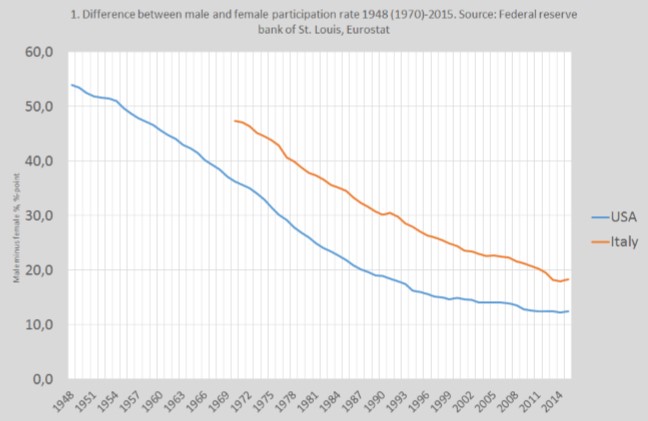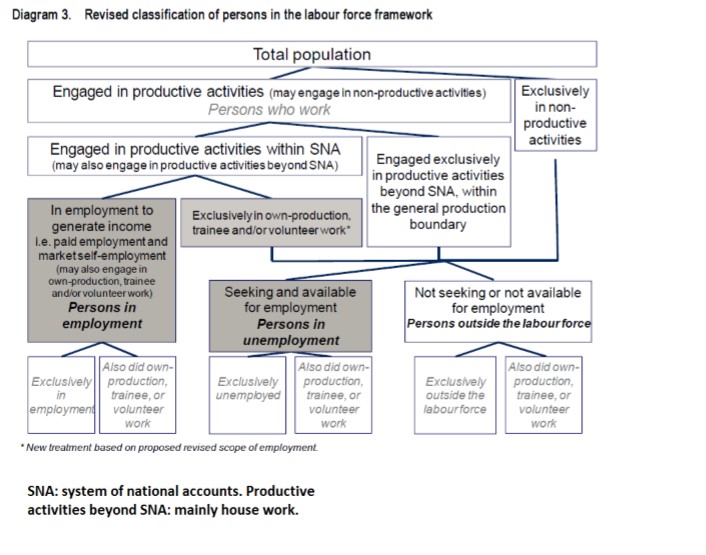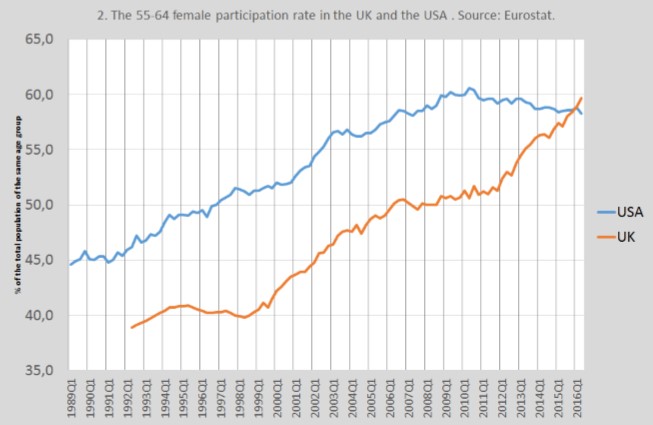Models and measurement in economics 5—labour statistics
Download the WEA commentaries issue ›
We could have known. After 1991, in the wake of a hideous financial crisis, Finnish unemployment skyrocketed from 3% in 1991 to 17% in 1994. Unemployment declined again but even after fifteen years it was way higher than before the crisis. To rise, again, after 2008. And a lasting higher level of unemployment was not the only consequence of the post 1991 Finnish labour market carnage. The crisis also caused people to leave the labour market altogether. Which means that the participation rate – the percentage of the population seeking or having a job – also declined after 1991. To decline, again, after 2008. We know this as statisticians measure these variables. But why didn’t we understand these writings on the wall? Why do we still not take such events seriously enough? Was and is this because macro-economic models and ideas of the neoclassical kind, which are used inside central banks and by the European Commission, state that markets quickly return to ‘general equilibrium’ and publish studies which indicate that even unemployment rates as high as 20% are ‘natural’ and ‘optimal’? (Fioramanti and Waldmann 2016), even when the idea of ‘natural unemployment has been thoroughly discredited (Farmer 2013)? This piece investigates differences between the statistical concepts of ‘employment’, ‘unemployment’ and other ‘work’ related macro-economic variables on one hand and the theoretical concepts of such variables on the other hand. And we will see if macro-theorists indeed misunderstood developments like those in Finland. This is part of a series. The first four pieces in this series (here, here, here and here) were an introduction, a general comparison of the national accounts and macro theory and discussions of the concepts of capital and consumption.
- Labour statistics – a short introduction
Macro–economic labour statistics, like the rate of unemployment, are well known. But unemployment is only one of a whole set of indicators. Graph 1 shows the difference between the male and female participation rate in Italy and the USA – i.e. the difference between the percentage of men and women between 16 and 64 who either have a job or are searching for a job.

The development of this particular metric is intriguing: why did the male/female difference decline in such a regular and even almost mechanical fashion? Was this because of the introduction of the mechanization of the household by running water and washing machines (Ha-Joon Chang, 2010, also Cardia 2008)? Or was it The Pill (Goldin and Katz, 2002)? Answering these questions is not the topic of this post. But graph 1 shows that present day labour market data can be used for historical analysis of international changes of the gender composition of the labour market. Before we can start to answer them, however, we have to investigate what these data really measure (the participation data for instance include the unemployed). And we have to investigate if the Italian and USA data really match. And: what do we count as ‘employment’! The struggle of the statisticians with such questions will be discussed in the subsequent section. The ordeal of neoclassical macro-theory will be investigated in the third section.
- The statistical concept of labour: recent considerations
Between 28 January and 3 February 2013 a ‘Meeting of Experts in Labour Statistics on the Advancement of Employment and Unemployment Statistics’, organized by the International Labour Organization (ILO), took place in (of course) Geneva. One of the advances discussed was a change in the concept of employment and work: ‘The draft revised resolution introduces the first international definition of work for use in statistical measurement, according to which it comprises “all activities performed in economic units [including households, M.K.] by persons of any sex, in order to produce goods or services for consumption by others, or for own consumption’’’ (ILO 2013, lemma 105). Annex 1 of ILO 2013 (lemma 11 and 12) refines this concept – the sting in the tail being the demarcation between employment which, contrary to earlier definitions, is now defined as income generating activities and not as all work (including unpaid work) within the SNA boundaries:
‘For comprehensive measurement, all forms of work can be aggregated to arrive at the general concept of work. The various forms may be used separately or also combined as the basis for, in particular:
(a) employment, to produce statistics of the labour force that comprise unemployment statistics and other measures of labour underutilization;
(b) work within the SNA production boundary (2008), which consists of employment, own production of goods, trainee work and certain volunteer work activities as specified
(c) work beyond the SNA production boundary (2008), comprising own-production of services and certain volunteer work activities as specified.
Two basic observation units, the job and the person, are relevant to the measurement of work …. A job is defined as a set of tasks and duties performed, or meant to be performed, by one person for a single economic unit’
Aside from work and employment, the proposals of the Experts, which serve as guidelines for statistical offices all over the world, define ‘unemployment’ too. Unemployment is by definition involuntary, a situation which people actively are trying to change – which means that data have to be based upon the aggregated acts and ambitions of individuals and not upon for instance administrative records. Though international conferences are remarkably successful in producing a commonly accepted grid to measure such labour related variables, there are of course still national differences. Look here for a Eurostat per country overview of data gathering, processing and compilation practices in 31 countries. But by and large the statistical offices do try to estimate the same concept when it comes to unemployment and employment – events in Italy are about the same kind of employment and unemployment as the data assembled by the Bureau of Labour Statistics for the USA (the same cannot be stated for China, however, see Feng, Hu and Muffit 2015). As insights and economies evolve, such concepts evolve, too. At this moment employment includes certain, though not all, kinds of volunteer activities. Supervising a non-profit is included, organizing your local neighborhood BBQ isn’t. One of the proposals of the ILO meeting mentioned above is however that many of these volunteer activities should not any longer be counted as ‘employment’ but separately as ‘volunteer work’ while ‘employment’ should be restricted to income generating work. Employment is measured in persons as well as in hours as well. Next to this, a clear distinction between employment, self-employment and self-employed employing others is made. Diagram 1 shows the classification according to the proposals, at present trainees and part of volunteers are classified as ‘employed’. As a consequence of the changes, the labour force will for instance be somewhat smaller and especially youth unemployment will be higher (as trainees are subtracted from the denominator).
The point: statistics of (un)employment and work are based upon careful consideration of internationally recognized concepts and definitions and the aggregation of data of individual situations and actions. See also Eurostat 2016A and 2016B. The result of recent considerations is that statistics will be more job, activity and income centered and less production centered while several kinds of unpaid work get their own statistical category. Despite these changes, statisticians will of course continue to measure dramatic changes in (un)employment like those in Finland, Italy and the USA. Are the concepts of macro-theorists also adapted to changing insights in the nature of the economy? This will be discussed in the next section.
- Macro-economic theory
After 2008 (and before, in the Finnish case) macro-economic labour statistics have not been kind to neoclassical macro theorists. Extremely high and tenacious unemployment in an increasing number of countries, lasting participation declines in countries with rising real wages, fast participation increases in countries with large real wage declines (graph 2) – it all flies in the face of neoclassical macro. How do these economists react?
Diagram 1. The revised classification of persons in the labour force framework as proposed by labour statistics experts
 Source: ILO, 2013
Source: ILO, 2013
The neoclassical macro-theoretical concept of employment is, when push comes to shove, fairly simple. People do not like to work and have to be paid to provide labour. The higher the (real) wage the more labour they provide (and hence the larger the labour force becomes). The concept of unemployment is nearly as simple: people are dismissed or enter the labour market and it takes them time to find a (new) job: search theory. This explains unemployment – though there may occasionally also be some short lived cyclical unemployment. A crucial assumption behind these ideas is ‘general equilibrium’: prices and quantities have adapted to a situation where the intertemporal ‘leisure, consumption and employment’ mix has reached an optimum (in fact: a maximum). This means that unemployment is by definition either of the ‘search theory’ type or quite temporary in case of a ‘shock’. There are empirical problems with these ideas. Post 2008, real wages in the UK declined with about 10% (OECD 2016; Tilly 2016). According to the neoclassical concept this should have led to an epic decline of the participation rate. But it didn’t: after a small drop in 2009 and stabilization in 2010 and 2011, UK labour market participation soared. At the same time real wages in the USA increased (OECD 2016). Despite this participation rates declined (graph 2 below). According to the models (which however do not take rising income or wealth inequality into consideration) the opposite should have happened. It has however to be added that the concept of labour used in the neoclassical models is remarkably fuzzy and authors do not seem to be in agreement if the models are about hours or people. Lawrence Cristiano e.a (2011) state in an overview of the state of the art in which Ht denotes the amount of ‘market work’ sold by households: ‘Under one interpretation, Ht represents the amount of hours worked by a typical person in the labor force … An alternative interpretation of Ht is that it represents the number of people working’. From a macro as well as from a micro perspective (as the authors admit), these are quite different animals! It is very well possible that employment declines with as much as 20% (like in Finland and later in Spain) while average hours per employed person do not drop. The fuzziness means that it’s not clear what neoclassical economists mean with an increase of Ht. Cristiano e.a. also state: ‘It is well known that much of the business cycle variation in employment reflects changes in the quantity of people working, not in the number of hours worked by a typical household’ and choose ‘persons’ instead of hours while assuming that especially ‘marginal’ workers like the elderly and ’spouses’ will enter the labour market when real wages increase. But this is their choice – there does not seem to be total agreement about this fundamental point. Anyway, taking ‘persons’ as a variable graph 2 shows that at least in the UK the participation rate of elderly women skyrocketed when real wages started to decline after 2008, while the opposite happened in the USA. The backward bending supply curve of labour, i.e. the idea that in the long run higher wages lead to a lower quantity of labour supplied (in hours per year), is sometimes mentioned by these economists (see the first part of this series) but it’s not in the models.

Events like these have not escaped the notice of neoclassical economists. Nucci and Riggi (2016) explain the absence of a decline of the participation rate in the EU by introducing the idea that home production is important, by assuming ‘habit persistence’ (i.e. the idea that people do not like the drop of consumption caused by becoming unemployed or, in plain Anglo-Saxon, ‘the rent has to be paid’) and the idea that wages are sticky, which lures people into the labour force (alas, their household economy is still not the dynamic, investing sector with the kind of mayor technological progress which contributed so much to the rise of the female participation rate). Together, these ideas enable them to ‘explain’ the problem of the absence of a decline of the participation rate. Aside: they call higher unemployment ‘additional looseness in the labour market’. Their variables can however in no way explain events like in the UK where wages declined by 10% while participation increased. Another problem with neoclassical ideas, extreme unemployment in countries like Spain and Greece, is tackled by Casares and Vasquez (2016, see also Casares 2010). In countries like Spain and Greece unemployment increased from an already high 6 to 7% to around 25% in a few years which, as even some (but not all!) neoclassical economists concede, cannot be explained by ‘search theory’. By ‘not all’ I mean the economists of the European commission, whose estimates of 22% ‘natural unemployment’ in Spain have not only been ridiculed on ‘heterodox’ economics blogs but also by the Wall Street Journal (Dalton 2016). Casares and Vasquez explain Über-unemployment in Spain using ‘habit persistence’ as well as wages which are set too high by the households (the models are not explicit about the coordination mechanism), which lures too many people to the labour market. Such studies however still use the general equilibrium framework and the assumption that the ‘right’ level of real wages will quickly solve the problem of unemployment, either by driving people out of the labour force or by increasing production. (Un)employment and wages statistics are not kind to this idea, surely not as real wages in countries like Spain and Greece did show considerable decreases (according to OECD data) without a concomitant drop in the participation rate. Despite this the basic ideas are not changed.
A more fundamental change is proposed by Roger Farmer, who sticks to the rational expectations of the neoclassical macro models and the use of micro-economic utility functions to derive intertemporal optimization of consumption (perhaps the most accessible of his articles: Farmer 2016). But he cuts the consumption-wage-employment nexus out of the models. By severing the relation between consumption, wages and labor supply he also destroys the general equilibrium and ‘natural unemployment’ setting of these models, which enables a model with ‘multiple equilibria’ – which enables a description what happened in Finland (and Spain and Greece and Eastern Germany and…). Farmer is also much more explicit about the differences between hours, people and the participation rate and does not shy away for a slightly inductive approach, taking (un)employment statistics at face value. Instead of a DSGE model (Dynamic Stochastic General Equilibrium) such models might be called DSIE models, with ‘I’ for ‘indeterminate’. At this moment, Farmer is however not a ‘representative DSGE economist’. Ideas like his might soon carry the day – but that day has not yet arrived.
- A comparison (not)
The plan was to provide a diagram with a comparison of concepts of the labour market of statisticians and DSGE models. At this moment, however, mainstream DSGE models are too fuzzy about hours, persons, and a ‘natural unemployment’ variable which they are unable to measure (Fioramanti and Waldmann, 2016; Farmer 2013) that there is little point in doing this. Which, as precise statistical concepts and measurements have been around for decades, leads to the question if this fuzziness might be the very goal of these models. The work of Fioramanti and Waldmann (2016) suggests so. They state that official (indirect) estimates of the ‘natural rate of unemployment’ for the countries of the EU fail on all scientific accounts. They are, however, still used to discipline countries. More precise concepts might, as Fioramanti and Waldmann suggest, prevent such disciplining or at least mitigate it. Writing this post made me even more aware of this situation. And less happy about the state of theoretical macroeconomics.
Literature
Cardia, Emanuala (2008). ‘Household Technology: Was it the Engine of Liberation?’. Mimeo, available here.
Casares, Miguel (2010). ‘Unemployment as excess supply of labor: implications for wage and price inflation’. Journal of Monetary Economics 57-2 pp. 233-243
Casares Miguel and Jesús Vázquez (2016), ‘Why are labor markets in Spain and Germany so different?’. Working paper, available here
Chang, Ha-Joon (2010). 23 things they don’t tell you about capitalism. Londen: Allan Lane.
Christiano, Lawrence J., Mathias Trabandt and Karl Walentin (2011). ‘DSGE Models for Monetary Policy Analysis’ in: Handbook of Monetary Economics, Volume 3A pp. 286-384. Elsevier
Dalton, Matthew (blogpost on the Real Time Brussels blog, 30 September 2014). ‘Questions about Europe’s ‘natural’ unemployment-rate estimates’. Available here.
Eurostat (2016A), Statistics explained. Labour market and Labour force survey (LFS) statistics’, available here
Eurostat (2016B), Statistics explained. Underemployment and potential additional labour force statistics, available here
Farmer, R. (2013), ‘The Natural Rate Hypothesis: an idea past its sell-by date’. Bank of England Quarterly Bulletin, September Q3, pages 244-256.
Feng, Shuaizhang, Yingyao Hu and Robert Muffit (2015), ‘Long Run Trends in Unemployment and Labor Force Participation in China’. NBER Working Paper No. 21460.
Fioramanti, Marco and Robert Waldmann (blogpost at Voxeu, 19 November 2016). ‘The Stability and Growth Pact: Econometrics and its consequences for human beings’. Available here.
Goldin, Claudia and Lawrence F. Katz. 2002. ‘The power of the pill: Oral contraceptives and women’s career and marriage decisions’. Journal of Political Economy 110-4 pp. 730-770.
International Labour Organization (2013). ‘Statistics of work and of the labour force. Report for discussion at the Meeting of Experts in Labour Statistics on the Advancement of Employment and Unemployment Statistics (Geneva, 28 January–1 February 2013)’. Department of Statistics MESEU/2013 Geneva
Nucci, Fransesco and Marianna Riggi (2016), ‘Labor force participation, wage rigidities, and inflation’. Banca d’Italia, Temi di Discussione 1054. Available here.
Tily, Geof (blogpost, 27 July 2016). ‘UK real wages decline of over 10% is the most severe in the OECD (equal to Greece)’. Available here
From: pp.11-15 of World Economics Association Newsletter 6(6), December 2016
https://www.worldeconomicsassociation.org/files/Issue6-6.pdf